Academic Skills: Analyzing Technology Adoption in Accounting & Finance
VerifiedAdded on 2023/06/10
|7
|1901
|255
Essay
AI Summary
This essay explores the impact of technology adoption on accounting and finance practices. It discusses the benefits, such as enhanced productivity, reduced forgery, and cost savings, stemming from digitized innovation, modern IT systems, and AI. The essay also addresses the negative impacts, including rising fiscal risks, worker training challenges, and job losses due to automation. It concludes that while technology is crucial for long-term success, businesses must carefully manage its implementation to mitigate potential adverse effects, such as cyber threats and workforce displacement. The essay references various books and journals to support its analysis of the evolving relationship between technology and financial operations.

Academic Skills for
Accounting and
Finance
Accounting and
Finance
Paraphrase This Document
Need a fresh take? Get an instant paraphrase of this document with our AI Paraphraser
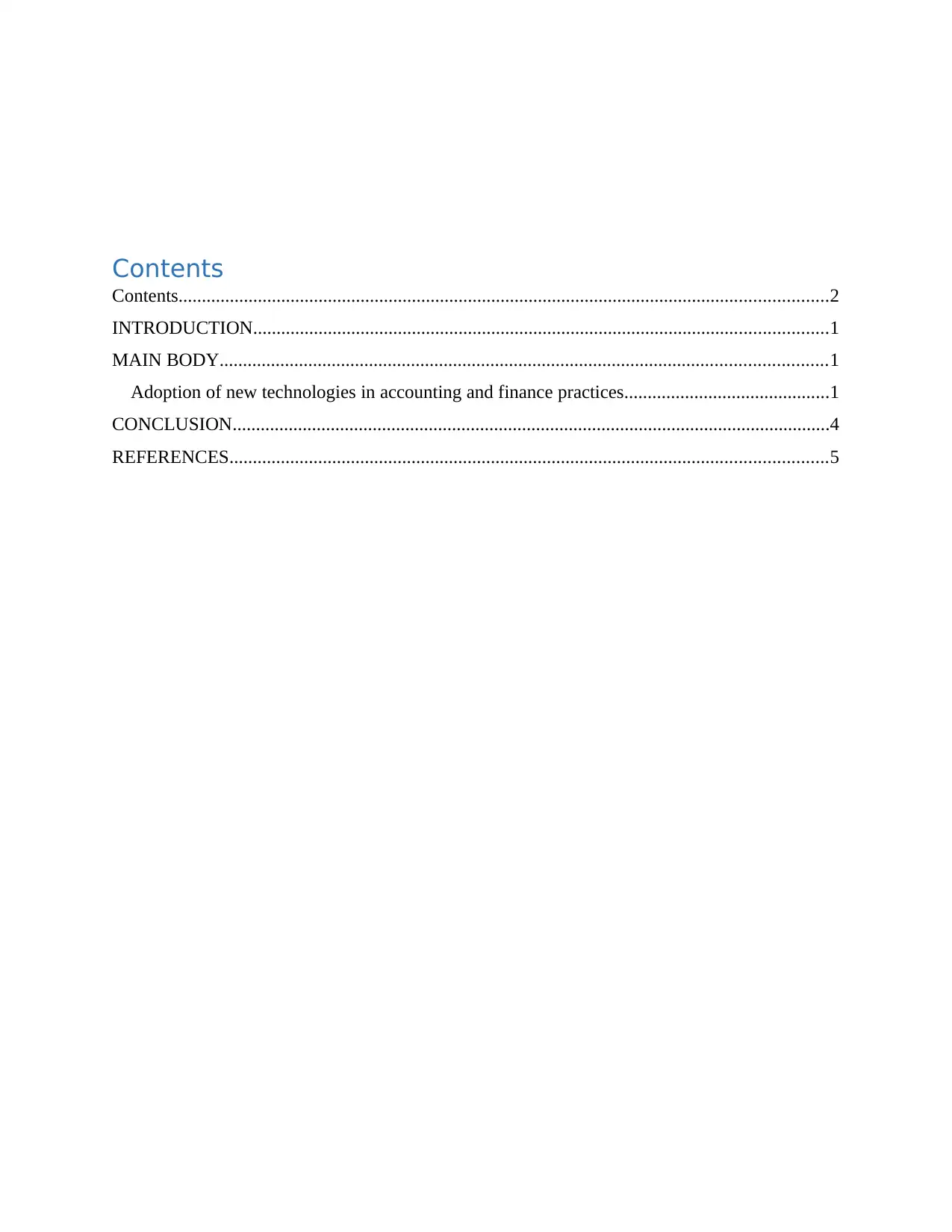
Contents
Contents...........................................................................................................................................2
INTRODUCTION...........................................................................................................................1
MAIN BODY..................................................................................................................................1
Adoption of new technologies in accounting and finance practices............................................1
CONCLUSION................................................................................................................................4
REFERENCES................................................................................................................................5
Contents...........................................................................................................................................2
INTRODUCTION...........................................................................................................................1
MAIN BODY..................................................................................................................................1
Adoption of new technologies in accounting and finance practices............................................1
CONCLUSION................................................................................................................................4
REFERENCES................................................................................................................................5
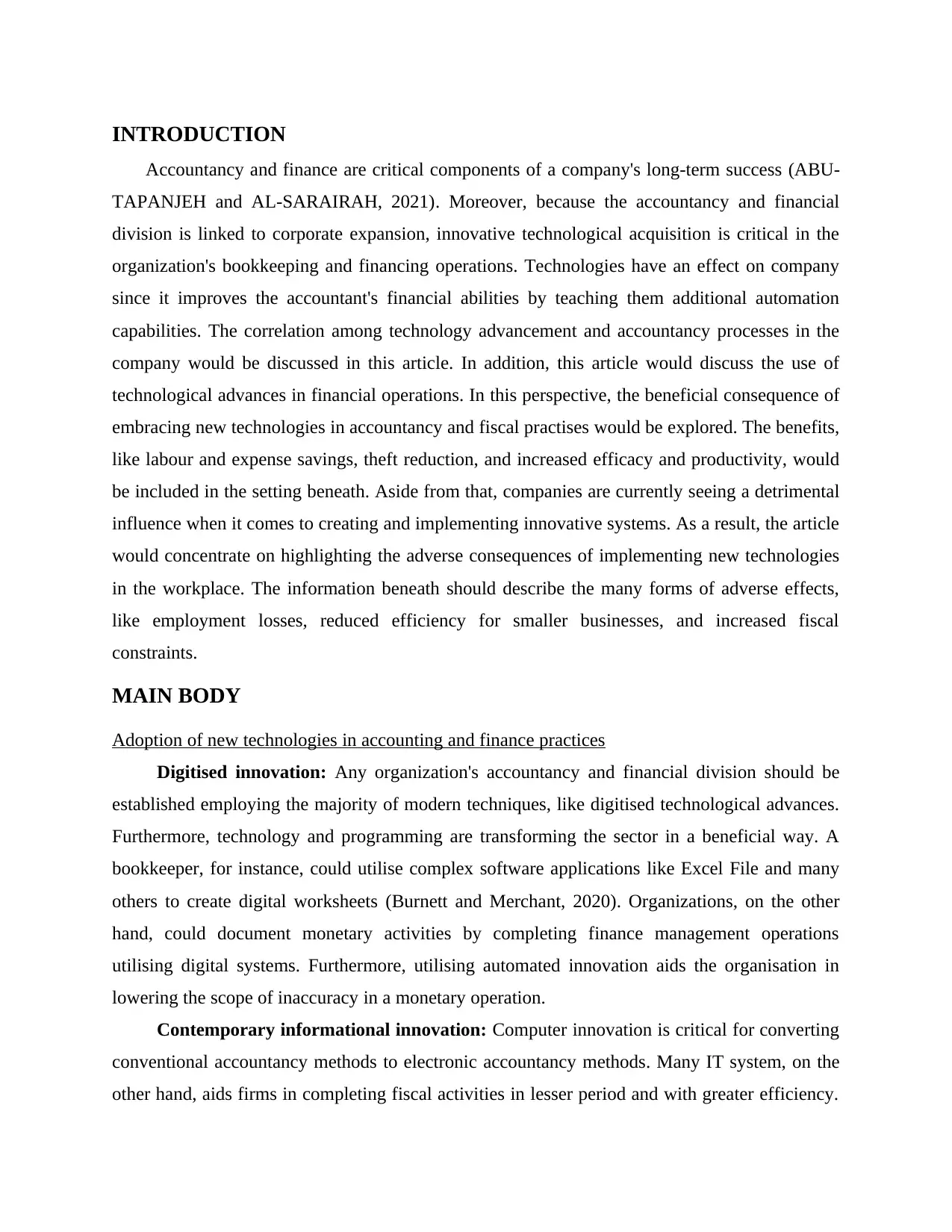
INTRODUCTION
Accountancy and finance are critical components of a company's long-term success (ABU-
TAPANJEH and AL-SARAIRAH, 2021). Moreover, because the accountancy and financial
division is linked to corporate expansion, innovative technological acquisition is critical in the
organization's bookkeeping and financing operations. Technologies have an effect on company
since it improves the accountant's financial abilities by teaching them additional automation
capabilities. The correlation among technology advancement and accountancy processes in the
company would be discussed in this article. In addition, this article would discuss the use of
technological advances in financial operations. In this perspective, the beneficial consequence of
embracing new technologies in accountancy and fiscal practises would be explored. The benefits,
like labour and expense savings, theft reduction, and increased efficacy and productivity, would
be included in the setting beneath. Aside from that, companies are currently seeing a detrimental
influence when it comes to creating and implementing innovative systems. As a result, the article
would concentrate on highlighting the adverse consequences of implementing new technologies
in the workplace. The information beneath should describe the many forms of adverse effects,
like employment losses, reduced efficiency for smaller businesses, and increased fiscal
constraints.
MAIN BODY
Adoption of new technologies in accounting and finance practices
Digitised innovation: Any organization's accountancy and financial division should be
established employing the majority of modern techniques, like digitised technological advances.
Furthermore, technology and programming are transforming the sector in a beneficial way. A
bookkeeper, for instance, could utilise complex software applications like Excel File and many
others to create digital worksheets (Burnett and Merchant, 2020). Organizations, on the other
hand, could document monetary activities by completing finance management operations
utilising digital systems. Furthermore, utilising automated innovation aids the organisation in
lowering the scope of inaccuracy in a monetary operation.
Contemporary informational innovation: Computer innovation is critical for converting
conventional accountancy methods to electronic accountancy methods. Many IT system, on the
other hand, aids firms in completing fiscal activities in lesser period and with greater efficiency.
Accountancy and finance are critical components of a company's long-term success (ABU-
TAPANJEH and AL-SARAIRAH, 2021). Moreover, because the accountancy and financial
division is linked to corporate expansion, innovative technological acquisition is critical in the
organization's bookkeeping and financing operations. Technologies have an effect on company
since it improves the accountant's financial abilities by teaching them additional automation
capabilities. The correlation among technology advancement and accountancy processes in the
company would be discussed in this article. In addition, this article would discuss the use of
technological advances in financial operations. In this perspective, the beneficial consequence of
embracing new technologies in accountancy and fiscal practises would be explored. The benefits,
like labour and expense savings, theft reduction, and increased efficacy and productivity, would
be included in the setting beneath. Aside from that, companies are currently seeing a detrimental
influence when it comes to creating and implementing innovative systems. As a result, the article
would concentrate on highlighting the adverse consequences of implementing new technologies
in the workplace. The information beneath should describe the many forms of adverse effects,
like employment losses, reduced efficiency for smaller businesses, and increased fiscal
constraints.
MAIN BODY
Adoption of new technologies in accounting and finance practices
Digitised innovation: Any organization's accountancy and financial division should be
established employing the majority of modern techniques, like digitised technological advances.
Furthermore, technology and programming are transforming the sector in a beneficial way. A
bookkeeper, for instance, could utilise complex software applications like Excel File and many
others to create digital worksheets (Burnett and Merchant, 2020). Organizations, on the other
hand, could document monetary activities by completing finance management operations
utilising digital systems. Furthermore, utilising automated innovation aids the organisation in
lowering the scope of inaccuracy in a monetary operation.
Contemporary informational innovation: Computer innovation is critical for converting
conventional accountancy methods to electronic accountancy methods. Many IT system, on the
other hand, aids firms in completing fiscal activities in lesser period and with greater efficiency.
⊘ This is a preview!⊘
Do you want full access?
Subscribe today to unlock all pages.

Trusted by 1+ million students worldwide
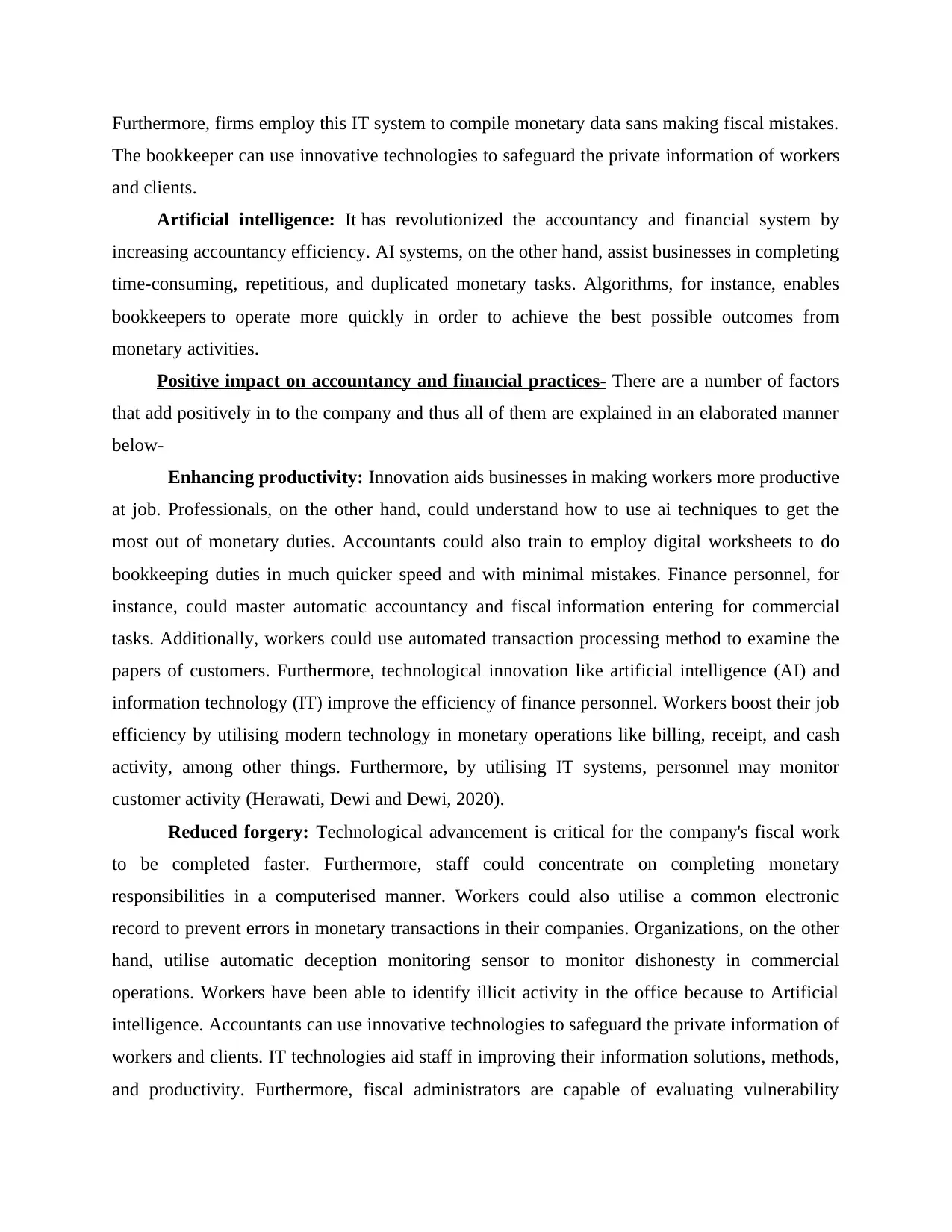
Furthermore, firms employ this IT system to compile monetary data sans making fiscal mistakes.
The bookkeeper can use innovative technologies to safeguard the private information of workers
and clients.
Artificial intelligence: It has revolutionized the accountancy and financial system by
increasing accountancy efficiency. AI systems, on the other hand, assist businesses in completing
time-consuming, repetitious, and duplicated monetary tasks. Algorithms, for instance, enables
bookkeepers to operate more quickly in order to achieve the best possible outcomes from
monetary activities.
Positive impact on accountancy and financial practices- There are a number of factors
that add positively in to the company and thus all of them are explained in an elaborated manner
below-
Enhancing productivity: Innovation aids businesses in making workers more productive
at job. Professionals, on the other hand, could understand how to use ai techniques to get the
most out of monetary duties. Accountants could also train to employ digital worksheets to do
bookkeeping duties in much quicker speed and with minimal mistakes. Finance personnel, for
instance, could master automatic accountancy and fiscal information entering for commercial
tasks. Additionally, workers could use automated transaction processing method to examine the
papers of customers. Furthermore, technological innovation like artificial intelligence (AI) and
information technology (IT) improve the efficiency of finance personnel. Workers boost their job
efficiency by utilising modern technology in monetary operations like billing, receipt, and cash
activity, among other things. Furthermore, by utilising IT systems, personnel may monitor
customer activity (Herawati, Dewi and Dewi, 2020).
Reduced forgery: Technological advancement is critical for the company's fiscal work
to be completed faster. Furthermore, staff could concentrate on completing monetary
responsibilities in a computerised manner. Workers could also utilise a common electronic
record to prevent errors in monetary transactions in their companies. Organizations, on the other
hand, utilise automatic deception monitoring sensor to monitor dishonesty in commercial
operations. Workers have been able to identify illicit activity in the office because to Artificial
intelligence. Accountants can use innovative technologies to safeguard the private information of
workers and clients. IT technologies aid staff in improving their information solutions, methods,
and productivity. Furthermore, fiscal administrators are capable of evaluating vulnerability
The bookkeeper can use innovative technologies to safeguard the private information of workers
and clients.
Artificial intelligence: It has revolutionized the accountancy and financial system by
increasing accountancy efficiency. AI systems, on the other hand, assist businesses in completing
time-consuming, repetitious, and duplicated monetary tasks. Algorithms, for instance, enables
bookkeepers to operate more quickly in order to achieve the best possible outcomes from
monetary activities.
Positive impact on accountancy and financial practices- There are a number of factors
that add positively in to the company and thus all of them are explained in an elaborated manner
below-
Enhancing productivity: Innovation aids businesses in making workers more productive
at job. Professionals, on the other hand, could understand how to use ai techniques to get the
most out of monetary duties. Accountants could also train to employ digital worksheets to do
bookkeeping duties in much quicker speed and with minimal mistakes. Finance personnel, for
instance, could master automatic accountancy and fiscal information entering for commercial
tasks. Additionally, workers could use automated transaction processing method to examine the
papers of customers. Furthermore, technological innovation like artificial intelligence (AI) and
information technology (IT) improve the efficiency of finance personnel. Workers boost their job
efficiency by utilising modern technology in monetary operations like billing, receipt, and cash
activity, among other things. Furthermore, by utilising IT systems, personnel may monitor
customer activity (Herawati, Dewi and Dewi, 2020).
Reduced forgery: Technological advancement is critical for the company's fiscal work
to be completed faster. Furthermore, staff could concentrate on completing monetary
responsibilities in a computerised manner. Workers could also utilise a common electronic
record to prevent errors in monetary transactions in their companies. Organizations, on the other
hand, utilise automatic deception monitoring sensor to monitor dishonesty in commercial
operations. Workers have been able to identify illicit activity in the office because to Artificial
intelligence. Accountants can use innovative technologies to safeguard the private information of
workers and clients. IT technologies aid staff in improving their information solutions, methods,
and productivity. Furthermore, fiscal administrators are capable of evaluating vulnerability
Paraphrase This Document
Need a fresh take? Get an instant paraphrase of this document with our AI Paraphraser
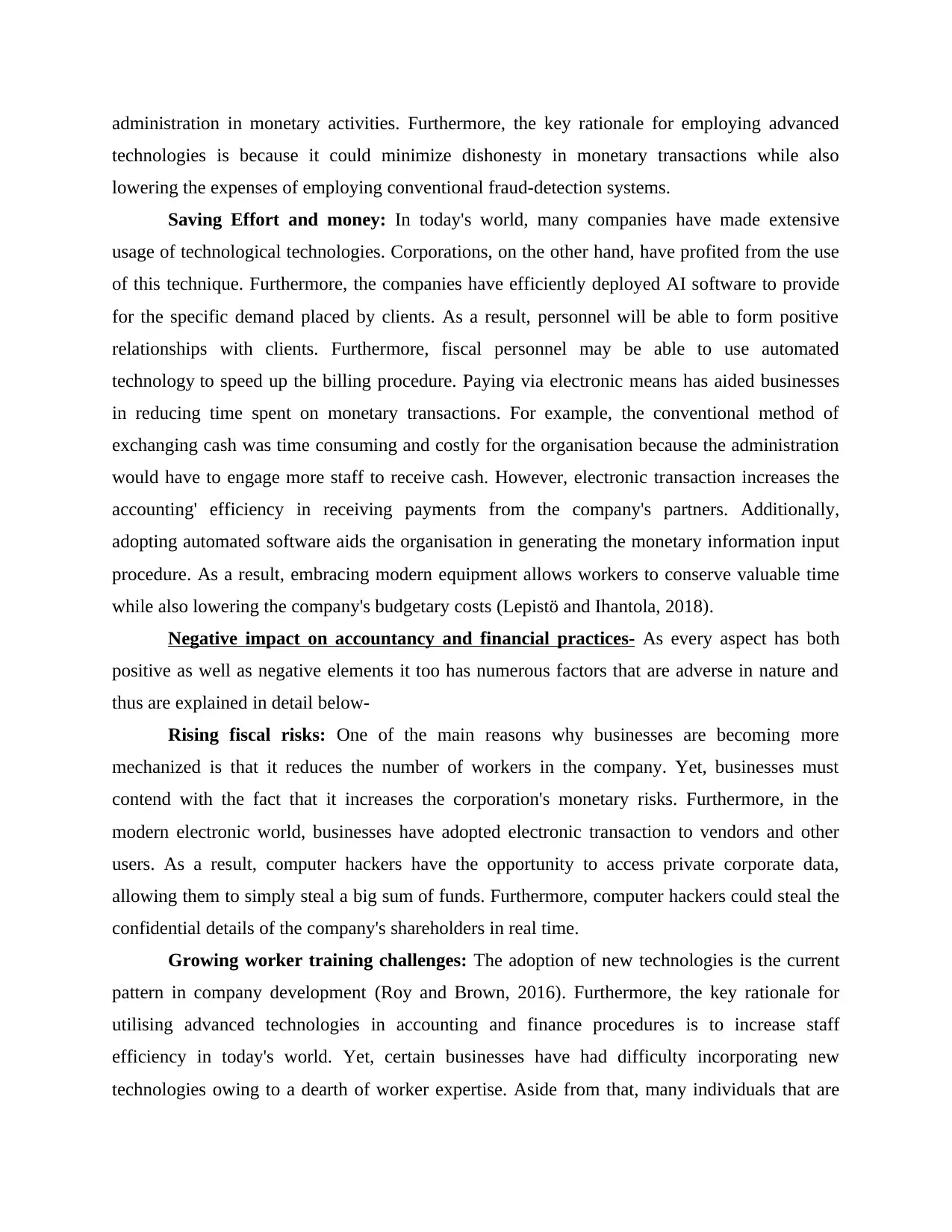
administration in monetary activities. Furthermore, the key rationale for employing advanced
technologies is because it could minimize dishonesty in monetary transactions while also
lowering the expenses of employing conventional fraud-detection systems.
Saving Effort and money: In today's world, many companies have made extensive
usage of technological technologies. Corporations, on the other hand, have profited from the use
of this technique. Furthermore, the companies have efficiently deployed AI software to provide
for the specific demand placed by clients. As a result, personnel will be able to form positive
relationships with clients. Furthermore, fiscal personnel may be able to use automated
technology to speed up the billing procedure. Paying via electronic means has aided businesses
in reducing time spent on monetary transactions. For example, the conventional method of
exchanging cash was time consuming and costly for the organisation because the administration
would have to engage more staff to receive cash. However, electronic transaction increases the
accounting' efficiency in receiving payments from the company's partners. Additionally,
adopting automated software aids the organisation in generating the monetary information input
procedure. As a result, embracing modern equipment allows workers to conserve valuable time
while also lowering the company's budgetary costs (Lepistö and Ihantola, 2018).
Negative impact on accountancy and financial practices- As every aspect has both
positive as well as negative elements it too has numerous factors that are adverse in nature and
thus are explained in detail below-
Rising fiscal risks: One of the main reasons why businesses are becoming more
mechanized is that it reduces the number of workers in the company. Yet, businesses must
contend with the fact that it increases the corporation's monetary risks. Furthermore, in the
modern electronic world, businesses have adopted electronic transaction to vendors and other
users. As a result, computer hackers have the opportunity to access private corporate data,
allowing them to simply steal a big sum of funds. Furthermore, computer hackers could steal the
confidential details of the company's shareholders in real time.
Growing worker training challenges: The adoption of new technologies is the current
pattern in company development (Roy and Brown, 2016). Furthermore, the key rationale for
utilising advanced technologies in accounting and finance procedures is to increase staff
efficiency in today's world. Yet, certain businesses have had difficulty incorporating new
technologies owing to a dearth of worker expertise. Aside from that, many individuals that are
technologies is because it could minimize dishonesty in monetary transactions while also
lowering the expenses of employing conventional fraud-detection systems.
Saving Effort and money: In today's world, many companies have made extensive
usage of technological technologies. Corporations, on the other hand, have profited from the use
of this technique. Furthermore, the companies have efficiently deployed AI software to provide
for the specific demand placed by clients. As a result, personnel will be able to form positive
relationships with clients. Furthermore, fiscal personnel may be able to use automated
technology to speed up the billing procedure. Paying via electronic means has aided businesses
in reducing time spent on monetary transactions. For example, the conventional method of
exchanging cash was time consuming and costly for the organisation because the administration
would have to engage more staff to receive cash. However, electronic transaction increases the
accounting' efficiency in receiving payments from the company's partners. Additionally,
adopting automated software aids the organisation in generating the monetary information input
procedure. As a result, embracing modern equipment allows workers to conserve valuable time
while also lowering the company's budgetary costs (Lepistö and Ihantola, 2018).
Negative impact on accountancy and financial practices- As every aspect has both
positive as well as negative elements it too has numerous factors that are adverse in nature and
thus are explained in detail below-
Rising fiscal risks: One of the main reasons why businesses are becoming more
mechanized is that it reduces the number of workers in the company. Yet, businesses must
contend with the fact that it increases the corporation's monetary risks. Furthermore, in the
modern electronic world, businesses have adopted electronic transaction to vendors and other
users. As a result, computer hackers have the opportunity to access private corporate data,
allowing them to simply steal a big sum of funds. Furthermore, computer hackers could steal the
confidential details of the company's shareholders in real time.
Growing worker training challenges: The adoption of new technologies is the current
pattern in company development (Roy and Brown, 2016). Furthermore, the key rationale for
utilising advanced technologies in accounting and finance procedures is to increase staff
efficiency in today's world. Yet, certain businesses have had difficulty incorporating new
technologies owing to a dearth of worker expertise. Aside from that, many individuals that are
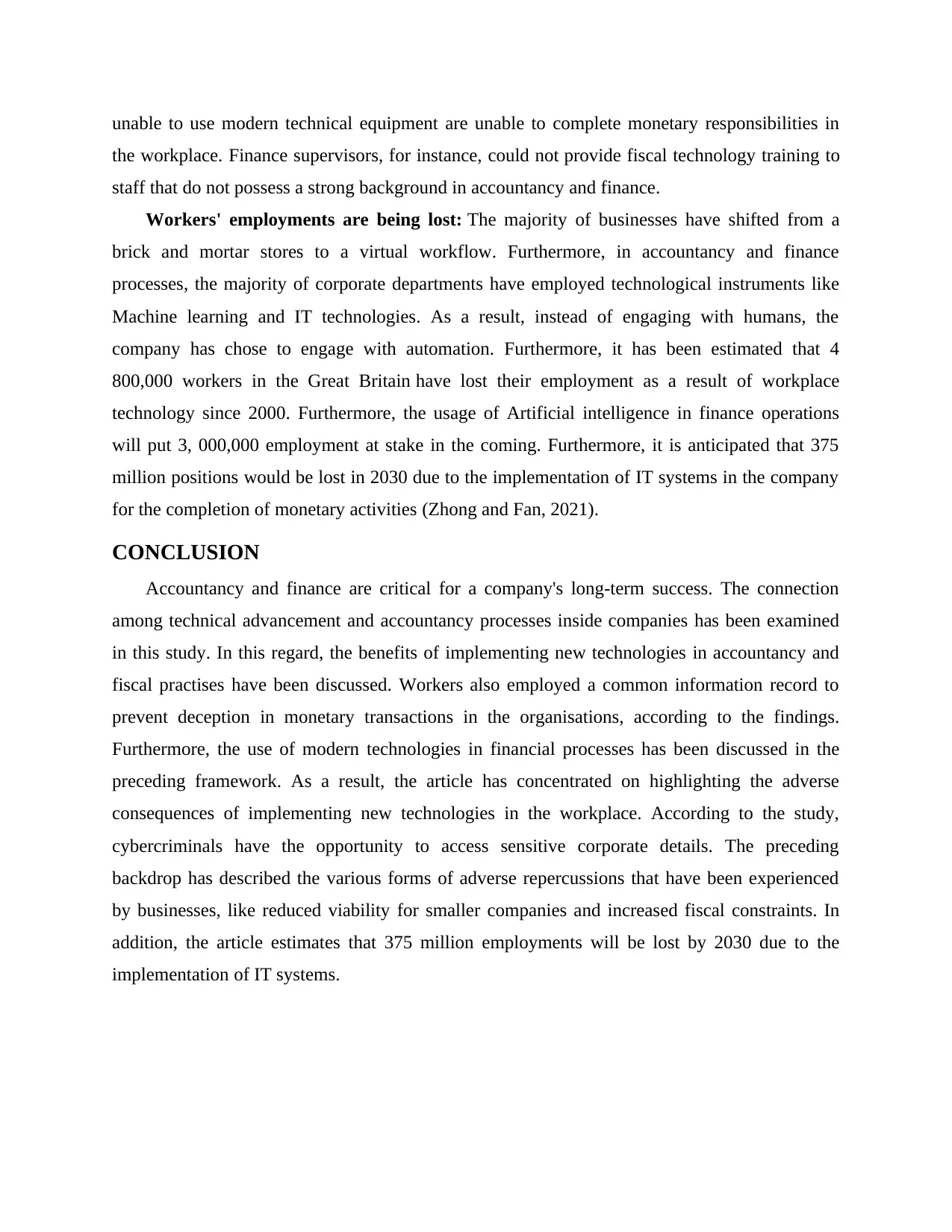
unable to use modern technical equipment are unable to complete monetary responsibilities in
the workplace. Finance supervisors, for instance, could not provide fiscal technology training to
staff that do not possess a strong background in accountancy and finance.
Workers' employments are being lost: The majority of businesses have shifted from a
brick and mortar stores to a virtual workflow. Furthermore, in accountancy and finance
processes, the majority of corporate departments have employed technological instruments like
Machine learning and IT technologies. As a result, instead of engaging with humans, the
company has chose to engage with automation. Furthermore, it has been estimated that 4
800,000 workers in the Great Britain have lost their employment as a result of workplace
technology since 2000. Furthermore, the usage of Artificial intelligence in finance operations
will put 3, 000,000 employment at stake in the coming. Furthermore, it is anticipated that 375
million positions would be lost in 2030 due to the implementation of IT systems in the company
for the completion of monetary activities (Zhong and Fan, 2021).
CONCLUSION
Accountancy and finance are critical for a company's long-term success. The connection
among technical advancement and accountancy processes inside companies has been examined
in this study. In this regard, the benefits of implementing new technologies in accountancy and
fiscal practises have been discussed. Workers also employed a common information record to
prevent deception in monetary transactions in the organisations, according to the findings.
Furthermore, the use of modern technologies in financial processes has been discussed in the
preceding framework. As a result, the article has concentrated on highlighting the adverse
consequences of implementing new technologies in the workplace. According to the study,
cybercriminals have the opportunity to access sensitive corporate details. The preceding
backdrop has described the various forms of adverse repercussions that have been experienced
by businesses, like reduced viability for smaller companies and increased fiscal constraints. In
addition, the article estimates that 375 million employments will be lost by 2030 due to the
implementation of IT systems.
the workplace. Finance supervisors, for instance, could not provide fiscal technology training to
staff that do not possess a strong background in accountancy and finance.
Workers' employments are being lost: The majority of businesses have shifted from a
brick and mortar stores to a virtual workflow. Furthermore, in accountancy and finance
processes, the majority of corporate departments have employed technological instruments like
Machine learning and IT technologies. As a result, instead of engaging with humans, the
company has chose to engage with automation. Furthermore, it has been estimated that 4
800,000 workers in the Great Britain have lost their employment as a result of workplace
technology since 2000. Furthermore, the usage of Artificial intelligence in finance operations
will put 3, 000,000 employment at stake in the coming. Furthermore, it is anticipated that 375
million positions would be lost in 2030 due to the implementation of IT systems in the company
for the completion of monetary activities (Zhong and Fan, 2021).
CONCLUSION
Accountancy and finance are critical for a company's long-term success. The connection
among technical advancement and accountancy processes inside companies has been examined
in this study. In this regard, the benefits of implementing new technologies in accountancy and
fiscal practises have been discussed. Workers also employed a common information record to
prevent deception in monetary transactions in the organisations, according to the findings.
Furthermore, the use of modern technologies in financial processes has been discussed in the
preceding framework. As a result, the article has concentrated on highlighting the adverse
consequences of implementing new technologies in the workplace. According to the study,
cybercriminals have the opportunity to access sensitive corporate details. The preceding
backdrop has described the various forms of adverse repercussions that have been experienced
by businesses, like reduced viability for smaller companies and increased fiscal constraints. In
addition, the article estimates that 375 million employments will be lost by 2030 due to the
implementation of IT systems.
⊘ This is a preview!⊘
Do you want full access?
Subscribe today to unlock all pages.

Trusted by 1+ million students worldwide
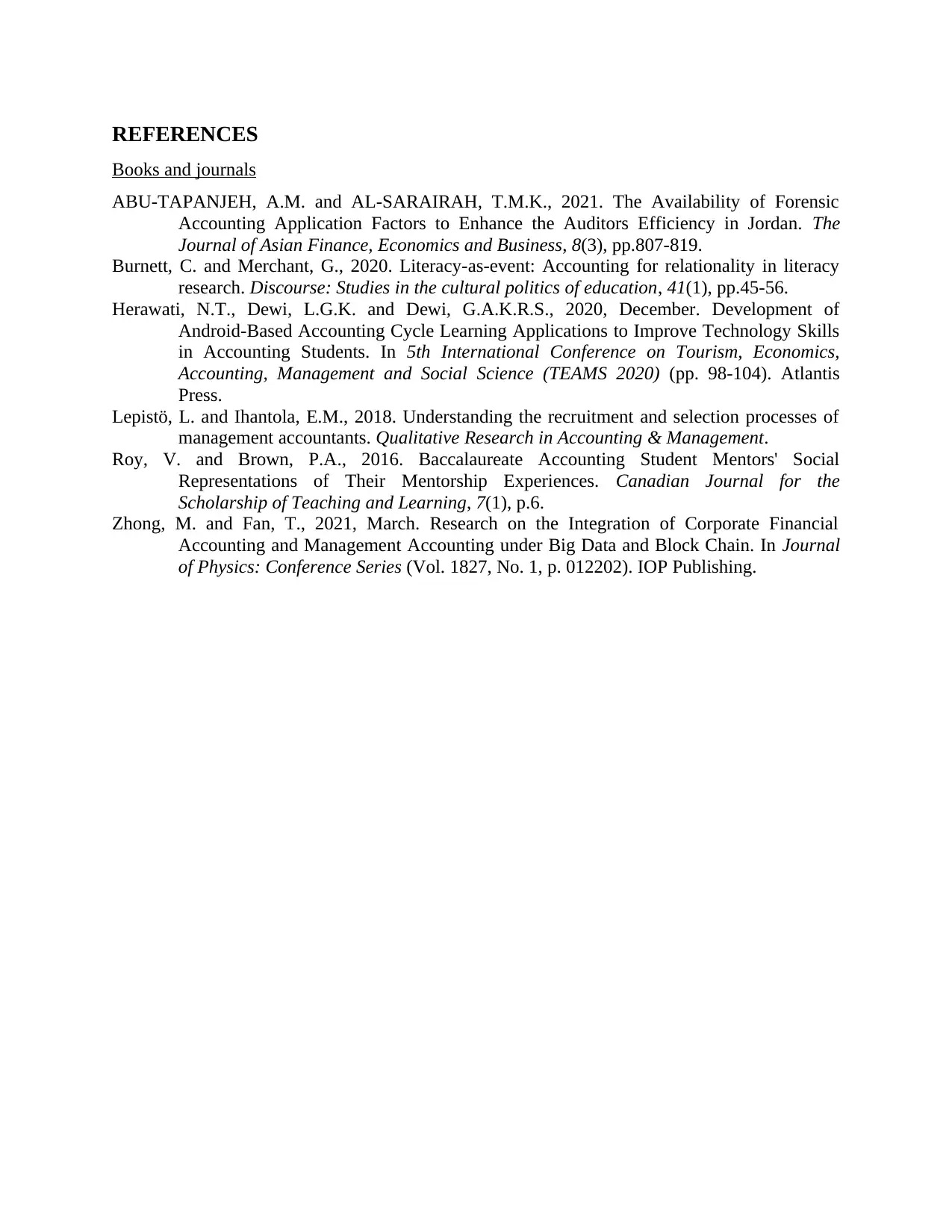
REFERENCES
Books and journals
ABU-TAPANJEH, A.M. and AL-SARAIRAH, T.M.K., 2021. The Availability of Forensic
Accounting Application Factors to Enhance the Auditors Efficiency in Jordan. The
Journal of Asian Finance, Economics and Business, 8(3), pp.807-819.
Burnett, C. and Merchant, G., 2020. Literacy-as-event: Accounting for relationality in literacy
research. Discourse: Studies in the cultural politics of education, 41(1), pp.45-56.
Herawati, N.T., Dewi, L.G.K. and Dewi, G.A.K.R.S., 2020, December. Development of
Android-Based Accounting Cycle Learning Applications to Improve Technology Skills
in Accounting Students. In 5th International Conference on Tourism, Economics,
Accounting, Management and Social Science (TEAMS 2020) (pp. 98-104). Atlantis
Press.
Lepistö, L. and Ihantola, E.M., 2018. Understanding the recruitment and selection processes of
management accountants. Qualitative Research in Accounting & Management.
Roy, V. and Brown, P.A., 2016. Baccalaureate Accounting Student Mentors' Social
Representations of Their Mentorship Experiences. Canadian Journal for the
Scholarship of Teaching and Learning, 7(1), p.6.
Zhong, M. and Fan, T., 2021, March. Research on the Integration of Corporate Financial
Accounting and Management Accounting under Big Data and Block Chain. In Journal
of Physics: Conference Series (Vol. 1827, No. 1, p. 012202). IOP Publishing.
Books and journals
ABU-TAPANJEH, A.M. and AL-SARAIRAH, T.M.K., 2021. The Availability of Forensic
Accounting Application Factors to Enhance the Auditors Efficiency in Jordan. The
Journal of Asian Finance, Economics and Business, 8(3), pp.807-819.
Burnett, C. and Merchant, G., 2020. Literacy-as-event: Accounting for relationality in literacy
research. Discourse: Studies in the cultural politics of education, 41(1), pp.45-56.
Herawati, N.T., Dewi, L.G.K. and Dewi, G.A.K.R.S., 2020, December. Development of
Android-Based Accounting Cycle Learning Applications to Improve Technology Skills
in Accounting Students. In 5th International Conference on Tourism, Economics,
Accounting, Management and Social Science (TEAMS 2020) (pp. 98-104). Atlantis
Press.
Lepistö, L. and Ihantola, E.M., 2018. Understanding the recruitment and selection processes of
management accountants. Qualitative Research in Accounting & Management.
Roy, V. and Brown, P.A., 2016. Baccalaureate Accounting Student Mentors' Social
Representations of Their Mentorship Experiences. Canadian Journal for the
Scholarship of Teaching and Learning, 7(1), p.6.
Zhong, M. and Fan, T., 2021, March. Research on the Integration of Corporate Financial
Accounting and Management Accounting under Big Data and Block Chain. In Journal
of Physics: Conference Series (Vol. 1827, No. 1, p. 012202). IOP Publishing.
1 out of 7
Related Documents
Your All-in-One AI-Powered Toolkit for Academic Success.
+13062052269
info@desklib.com
Available 24*7 on WhatsApp / Email
![[object Object]](/_next/static/media/star-bottom.7253800d.svg)
Unlock your academic potential
Copyright © 2020–2025 A2Z Services. All Rights Reserved. Developed and managed by ZUCOL.

